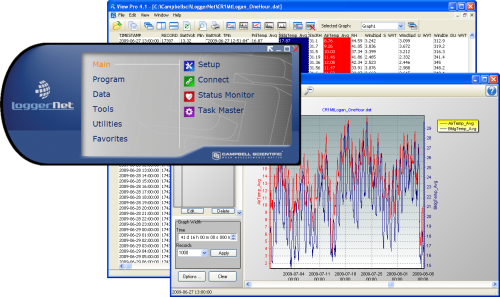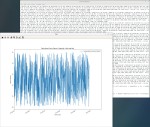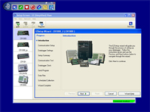
Contains advanced programming and communication capabilities






Overview
LoggerNet is our main data logger support software package. It supports programming, communication, and data retrieval between data loggers and a PC.
LoggerNet consists of a server application and several client applications integrated into a single product. It can support connection to a single data logger, but it is especially adept in applications that require telecommunications or scheduled data retrieval used in large data logger networks.
A copy of the current software license agreement (end-user license agreement) for LoggerNet is available in the LoggerNet Instruction Manual.
Read MoreBenefits and Features
- Creates custom data logger programs using Edlog or CRBasic
- Displays or graphs real-time or historic data
- Builds custom display screens to view data or control flags/ports
- Retrieves data using any of our telecommunication options
- Processes data files using Split
- Saves data in formats (including CSV and XML) that can be imported into third-party analysis packages
Images

Similar Products
Detailed Description
The standard LoggerNet software package is recommended for those who have data logger networks that do not require the more advanced features offered in LoggerNet Admin. It includes the LoggerNet server and client applications. The LoggerNet server stores the data in a cache and writes data to a variety of formats, including ASCII, binary, and XML.
The LoggerNet server and client applications enable you to do the following:
- Configure the server to communicate with multiple data loggers via a variety of communications hardware
- Create custom data logger programs using Short Cut, Edlog, or the CRBasic Editor
- Connect to a data logger to check or set the clock, send programs, or perform other administrative functions
- Collect data on demand or schedule
- Monitor and troubleshoot the network
- Display real-time data in a numeric display or graph
- View and graph data files
- Create graphical data displays that update when data is collected and allow you to control flags, ports, and variables
- Create automated tasks
- Process data files using Split
- Save data in formats (including CSV and XML) that can be imported into third-party analysis packages.
The client applications included in the standard LoggerNet software package are the following:
- Setup
- Connect
- Status Monitor
- Task Master
- Short Cut
- CRBasic Editor
- Edlog
- Transformer
- RTMC Development
- RTMC Run-Time
- View Pro
- Split
- CardConvert
- Troubleshooter
- Network Planner
- PakBus Graph
- LogTool
- Device Configuration Utility
- CoraScript
Version History
|
Compatibility
Please note: The following shows notable compatibility information. It is not a comprehensive list of all compatible products.
Dataloggers
| Product | Compatible | Note |
|---|---|---|
| 21X (retired) | The 21X requires three PROMs; two PROM 21X Microloggers are not compatible. | |
| CR10X (retired) | LoggerNet is compatible with the mixed array, PakBus®, and TD operating systems. | |
| CR23X (retired) | LoggerNet is compatible with the mixed array, PakBus®, and TD operating systems. | |
| CR510 (retired) | LoggerNet is compatible with the mixed array, PakBus®, and TD operating systems. |
Communication Devices
| Product | Compatible | Note |
|---|---|---|
| KonectPBRouter |
Software
| Product | Compatible | Note |
|---|---|---|
| KonectGDS |
Additional Compatibility Information
Data Logger Considerations
LoggerNet supports Campbell Scientific data loggers.
Communications
LoggerNet runs on a PC, using serial ports, telephony drivers, and Ethernet hardware to communicate with data loggers via phone modems, RF devices, and other peripherals.
Software
The development tool of RTMC Pro 1.x and 2.x is not compatible with the RTMC run-time and the standard RTMC development tool in LoggerNet 4. An upgrade for RTMC Pro must be purchased separately.
Computer
LoggerNet is a collection of 32-bit programs designed to run on Intel-based computers running Microsoft Windows operating systems. LoggerNet runs on Windows 10 and Windows 11. LoggerNet runs on both 32-bit and 64-bit versions of these operating systems.
Other Products
LoggerNet supports most commercially available sensors, SDM devices, multiplexers, relays, vibrating-wire interfaces, ET107, CompactFlash cards, microSD cards, and PC cards.
Specifications
| Operating System | Windows 11 or 10 (Both 32- and 64-bit operating systems are supported.) |
| Requirement | .NET 4.6.2 |
| Purchased Separately | Yes |
| Software Level | Intermediate to advanced |
| Communications Supported |
Direct connect, Ethernet, short-haul, phone modems (land-line, cellular, voice synthesized), RF transceivers (UHF, VHF, and spread spectrum), multidrop modems Combinations of communication devices supported. |
| Scheduled Data Collection Supported | Yes |
| Data Display Supported | Numeric, graphical, Boolean data objects |
Military Certificate of Networthiness (CoN) |
|
| Certifications |
|
Documents
Product Brochures
Videos & Tutorials
Downloads
LoggerNet Patch v.4.9 (419 MB) 02-10-2024
This patch will upgrade LoggerNet, LoggerNet Remote or LoggerNet Admin version 4.0 and newer to 4.9. A version of LoggerNet 4.x must be installed on the computer.
Note: This patch includes RTMC Run-time and the RTMC Standard Development v5.0.1. If you are using RTMC Pro 4.3.3 or older or CSI Web Server 1.6 or older and plan to continue creating RTMC projects, we recommend that you opt out on updating RTMC during the install or upgrade to RTMC Pro v5.0.1.
LoggerNet Admin and Remote:
A change was made in the way the LoggerNet 4.6 Server performs "Custom Data Collection". A corresponding change was made in the Connect Screen 4.6 client "Custom Data Collection" functionality.
If you require "Custom Data Collection" functionality with the Connect Screen client, assure that the LoggerNet Servers and Connect Screen clients are 4.6 or higher.
This application requires the Microsoft .Net 4.6.2 Framework. If it is not already installed on your computer, it can be obtained from the Microsoft Download Center.
Supported Operating Systems: (32 and 64 bit) Windows 11 or 10.
What's new in LoggerNet 4 Tutorial (exe format) v.- (12.9 MB) 14-09-2009
LoggerNet 4.0 was released in August of 2009. This tutorial demonstrates some of the new features and enhancements. Two new applications, View Pro and the Network Planner, are introduced.
LoggerNet Trial v.4.9 (423 MB) 02-10-2024
This is a fully functional 30 day trial of the standard version of LoggerNet. This is a trial only and can not be activated as a full version with a license key. (Network setup and data is preserved from the trial when installing the full version.)
Current LoggerNet users: It is recommended that you install the trial on a computer other than the one running your existing LoggerNet. If that is not practical, we strongly recommend you back up the LoggerNet working directory to prevent backward compatibility issues if you revert to a previous version. To revert you must re-install LoggerNet using the original disk and software key.
Note: This application requires the Microsoft .Net 4.6.2 Framework. If it is not already installed on your computer, it can be obtained from the Microsoft Download Center.
Supported Operating Systems: (32 and 64 bit) Windows 11 or 10.
Frequently Asked Questions
Number of FAQs related to LoggerNet: 18
Expand AllCollapse All
-
There are several approaches you can try:
- The LNDB Interface can pull data from LoggerNet and insert it into a database instance. Supported database platforms are as follows: Microsoft SQL; MySQL; unofficially, MariaDB as it is open source MySQL, PostGRESQL, and Oracle. The database table structure and metadata will match the structure of the station’s program and the station name used in LoggerNet exactly. You cannot customize the structure. Refer to the setup documentation.
- Read or parse data from LoggerNet .dat files. The files are CSV formatted and can be parsed in using most any programming language. Files by default are stored on the LoggerNet computer in the following path: C:\Campbellsci\LoggerNet.
- LDMP Server, a LoggerNet Admin component, offers a listening socket for data to be pulled directly from the LoggerNet cache over the LoggerNet Service listening port 6789. Complete documentation in LoggerNet Admin is stored in the following path: C:\Program Files (x86)\Campbellsci\LoggerNet\ldmp_server2.pdf.
- Read in data using the CSI web server’s built in Web API. The webAPI accepts queries in the same format as the data logger’s built-in webAPI. Refer to the data logger webAPI documentation.
- The LNDB Interface can pull data from LoggerNet and insert it into a database instance. Supported database platforms are as follows: Microsoft SQL; MySQL; unofficially, MariaDB as it is open source MySQL, PostGRESQL, and Oracle. The database table structure and metadata will match the structure of the station’s program and the station name used in LoggerNet exactly. You cannot customize the structure. Refer to the setup documentation.
-
OSIsoft sells a PI interface for LoggerNet. The OSIsoft part number is PI-IN-CS-LN-NTI. Please direct all inquiries for sales and support of the interface to OSIsoft.
-
- LoggerNet 4.0 introduces a new look and feel to the LoggerNet Toolbar. Applications are divided into categories to make navigating the Toolbar easier. You can also organize a Favorites category for the applications that you use most often.
- A new file viewing application, View Pro, is introduced in which LoggerNet 4.0. View Pro allows you to graph data in a variety of formats including Line Graph, X- Y Plot, Histogram, Rainflow Histogram, and FFT(2D or 3D).
- Another new application, the Network Planner, is included. The Network Planner is a graphical application that assists the user in designing PakBus datalogger networks.
LoggerNet 4.0 includes many additional changes. See the preface to the LoggerNet manual for more details on what is new in LoggerNet 4.0 and each individual application.
-
Changes
- Enhanced performance of the CRBasic Editor when checking for matching parentheses.
Bug Fixes
Note: The following fixes only apply to customers who are upgrading to LoggerNet 3.1.1 from LoggerNet 2.x:
- Data file paths for table-based data loggers appeared to be distorted in the Setup Screen.
- Numeric Monitor displayed inlocs from some table-based data loggers incorrectly.
-
New features
- Support for the CR1000 throughout the software, including the Short Cut program generator
- EZSetup client
- Added a TroubleShooter client to help identify communications problems. This includes a new Communication Test tool.
- Users can check and set data logger clocks, and send programs from the Setup Screen.
- Status Monitor Screen added a communications history display; sorting by statistic can be done by clicking the column header.
- A new LogTool client provides access to the log displays. Users can limit messages to specific devices.
- RTMC added “auto-tabbing” and new time stamp formatting.
- Added a new utility called Device Configurator (DevConfig) to set the various settings in data loggers and communications peripherals. Settings can be saved to a file and loaded to other devices.
- Short Cut included various refinements such as drag-and-drop for output selection, and a 50 or 60 Hz noise rejection option.
- A new Transformer tool is provided to convert CR10X (mixed-array OS only) Edlog program (.dld or .csi) to a CR1000 CRBasic program (.CR1).
Changes
- Reorganized Setup Screen to distinguish between settings most users would need to edit and settings where the default usually works and which users typically won’t need to change.
- Integrated dynamic IP addressing in AirLink Ravens into Server settings.
- Server now locks the network when any client is trying to edit it to prevent “dueling clients.”
- Made PakBus ports independent, allowing the user to bridge or not bridge them to create sub-networks.
- Connect Screen functions work without having to "connect" to the data logger first.
- Numeric and Graph Screens update automatically for some types of data without being “connected” if the data is being collected via schedule.
- PakBus Graph is now more graphical in nature and allows easier access to device settings.
- LoggerNet Server offers a variety of refinements, including reintroduced support for RF95T base and remote devices for BMP1 networks, standalone PakBus routers assigned to each PakBus port, a new "hangUpDelay" setting, the ability to “lock” a device when its settings are being edited to prevent other clients from “dueling” for those settings, accepting one-way data notifications from PakBus data loggers, and accepting UDP packets from an AirLink modem (Raven or PinPoint) containing a new dynamic IP address.
-
There is a difference between the Toolbar initialization files used in earlier 3.x versions of the software and more recent versions.
To resolve this, close LoggerNet. Go to C:\Campbellsci\LoggerNet\sys\inifiles and delete the Toolbar.ini file. When LoggerNet is reopened, the Toolbar should display the default buttons.
-
Transformer is available within LoggerNet 3.2 and higher.
- From the Windows Start Menu, navigate to LoggerNet3.0 | Utilities | Transformer.
- In LoggerNet 4.x, from the main LoggerNet window, navigate to Program | Transformer.
-
A customer who owns any version of LoggerNet or PC400 can upgrade to LoggerNet version 4 by ordering LoggerNet/U.
A customer who does not own any version of LoggerNet or PC400 must purchase the full version of LoggerNet.
-
Yes. The “Getting Started with RTMC Tutorial” is available for download.
-
Yes. We have created a software application, Transformer, to help migrate CR23X program files to CR3000 program files. Transformer is available within LoggerNet 3.2 and higher.
- From the Windows Start Menu, navigate to LoggerNet3.0 | Utilities | Transformer.
- In LoggerNet 4.x, from the main LoggerNet window, navigate to Program | Transformer.
Transformer uses a .csi or .dld file created in Edlog to generate CRBasic code for a CR3000. A side-by-side comparison of the two programs is provided along with an action log that highlights parts of the program that may need attention or additional editing in CRBasic.
Casos de estudio
In 2019, Campbell Scientific embarked on a significant project with the Malawi Department of Climate......read more
When Dennis Quaintance decided to build the Proximity Hotel in Greensboro, North Carolina, he knew......read more
Landfills present many environmental challenges, ranging from odor control to groundwater quality. Continuous, accurate monitoring......read more
The 385-acre Chicago Botanic Garden welcomes more than 750,000 visitors each year. Its new Daniel......read more
The Oklahoma Mesonet is a statewide environmental monitoring network developed through the cooperative efforts of......read more
To gain access to more reliable weather information, the Port of Tyne added two new weather......read more





















